I’m obsessed with the gorgeous cherry blossom this spring, even more so knowing that you can eat most of it! In this article I’m going to look at the different edible Prunus/cherry species and varieties that you are most likely to find while foraging in the UK and Ireland.

Cherry Blossom
Cherry blossom is safe to eat raw in small quantities, by which I mean a few handfuls to decorate a salad or as a snack straight off the tree while walking in the park. But we should bear in mind that the slight almondy taste comes from cyanogenic compounds that could poison you if you ate enough in one go (though in small quantities, can be converted to vitamin B12. So, not all bad). These cyanogenic glucosides are broken down and reduced in quantity by various ways of processing and preserving the blossom – drying, cooking, pickling in salt or vinegar.
Cherry leaves are also considered edible, and are traditionally salt pickled in Japan for wrapping around sakura mochi – more on that later.
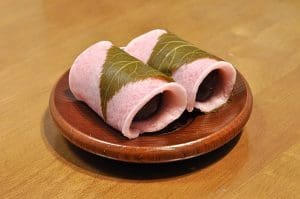
If you want to get straight to some more recipe ideas, scroll down to the bottom.
But first…
here’s some tips on how to distinguish different kinds of cherry blossom. By tasting them, you’ll find that some are sweeter, more bitter, more almondy or give a better green crunch to your salad – you just have to try them to find out which you like best. My personal favourites is a white double-ruffled ornamental that grows in my local park.
Native Cherry Blossom
First lets look at the native cherries that you could find growing wild pretty much anywhere. Cherries are in the genus Prunus, which also includes the other stone fruits such as peaches, almonds and plums. The flowers have five delicate petals, one long style in the middle, surrounded by many little anthers, looking a bit like a little firework. The clusters of leaves are neat elongated ovals, pointed at the end and serrated at the edge. The bark is generally shiny, especially on younger trunks and branches, with horizontal stripes called lenticels. They remind me a bit of tiger stripes or stretch marks.
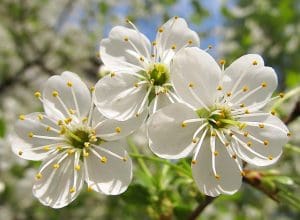
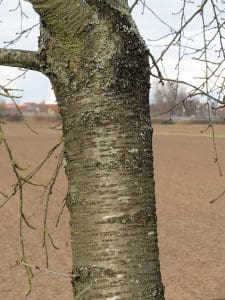
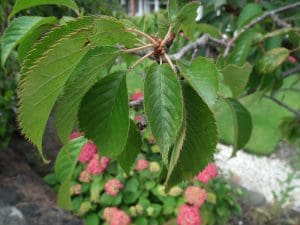
Plum blossoms (and its wild relative blackthorn) look similar, but are also edible, so its not a big deal if you confuse them. Peach, almond and apricot trees also have similar blossom and might also rarely turn up in the UK, but prefer warmer conditions, so you are only likely to find them being carefully looked after in a garden rather than out in the wild. Plums can be a bit more hardy, but still generally need some care to thrive so gardens and orchards are the most likely haunts. But just to clarify the main difference: cherry flowers have a long stalk and hang in clusters, while plum and the other stone fruits have a short stalk attached one by one close to the twig. Cherry petals often have a split in the end, particularly the Japanese varieties, while plum petals are round, and come from round buds – cherry buds tend to be more oval. Cherry leaves are long, symmetrically folded down the middle, and neat serrated at the edge: plum leaves are smaller, more rounded, and generally look more untidy. Blackthorn (wild plum) blossom is much smaller, and the bush can be distinguished by being very thorny and dense, more like a bush than a tree, and by the way it flowers earliest in the spring before its leaves come out – almost all the other plum hybrids and cherries have leaves emerging before or at the same time as blossom.
Wild Cherry Blossom
Main ‘wild’ cherry species
These are the trees you will most often find growing wild in the countryside or cropping up uninvited anywhere the seeds are spread by birds. Prunus avium, often called Sweet cherry, Wild cherry or bird Cherry,is native to Western Europe while Prunus cerasus , the Sour Cherry, is thought to originate as a hybrid between P. avium and the Central European native Prunus fruticosus.
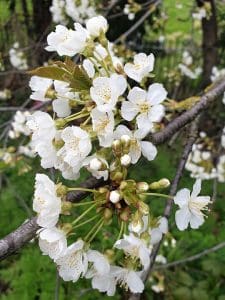
Given that the two can hybridize freely with other Prunus species, there is considerable genetic variation in how they look! Prunus avium is the tall elegant one, growing up to 30m. It has longer stems on the blossoms and open, swooping branches giving the impression of a bit of space and dangling movement. P. cerasus is shorter, up to 10m tall and has shorter blossom stems. Both produce shiny yellow to red fruits on dangling stems, and put on a show in autumn as their leaves change to bright yellows and reds. The Cherry Plum, P. cerasifera, is shorter still and has more plum-like features, blossoming early from greyer branches and more rough looking, matte leaves . The fruit is what really tells the difference, looking a lot more like a small, matte, colourful plum than a smaller and shiny long stemmed cherry.
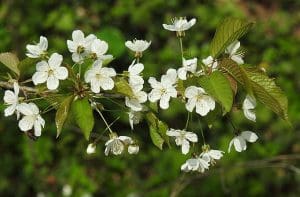
By Robert Flogaus-Faust – Own work, CC BY 4.0, https://commons.wikimedia.org/w/index.php?curid=74686626
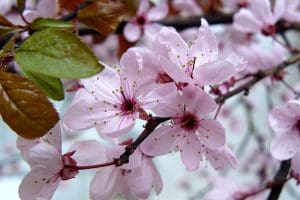
The native prunus that I would avoid because they don’t taste so good and may have higher cyanide content are cherry laurel prunus laurocerasus, and bird cherry prunus padus. Both of these have short-stemmed flowers clustered into a central spike, while the good edible cherry blossoms hang down on long individual stalks.
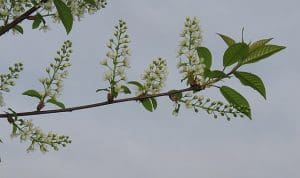
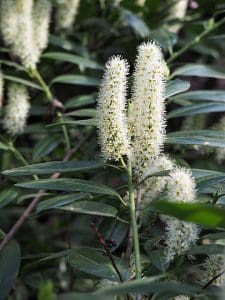
Ornamental Cherry Blossoms
Finally, lets look at the spectacular and often ruffly dense flowering ornamentals, that are beloved in parks and gardens and a great urban forage. Most originate in Japan, though the USA has also picked up the Japanese love for blossom and created more cultivars. In common with European and North African wild and cultivated varieties, they have shiny, stripy bark, neat symmetrical clusters of leaves, and long-stalked, dangling flowers.
The blossom is extra spectacular though, and can be any shade of pink to white, and if they have 5 single petals like their wild relatives, would generally look bigger and more showy in thick clusters. But they can just as likely have double that number of petals, or even have so many layers of ruffled petals that they look like a pom pom, so you can’t see the style and anthers anymore. Unsurprisingly these ruffled varieties tend not to produce fruit as pollinating insects can’t get in there either! But the more petals there are, the better for collecting enough quantity to make tea, jam, or sweet treats.
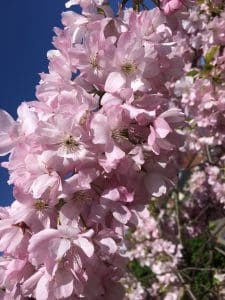
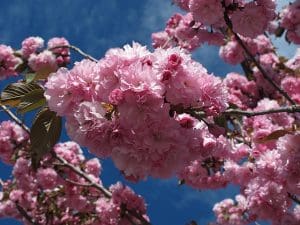
The precise species origin of Japanese flowering cherries is a little obscure and has caused some confusion until DNA research shows them mostly being hybrids of wild P. Speciosa, jamasakura and sargentii. So they tend to just be referred to as Prunus ‘variety name’ e.g. Prunus ‘Asano’. They are often grafted onto a vigorous wild cherry rootstock to help them grow better – if so you can usually see the graft scar somewhere on the trunk.
Here’s a Beginners guide to Japanese ornamental varieties.
The UK national collection of ornamental flowering cherries is at Keele University, and is worth a visit
Cherry Blosson Recipe time!
Common Wild cherry is tasty as a salad ingredient, garnish, or snack. I’ve personally found the white flowers of P. avium and the white ornamental varieties to be sweeter, but your mileage may vary! As long as you are confident that you have found a good edible cherry tree, you just have to taste a flower or two to decide if it would be better used for something sweet, savory or both.
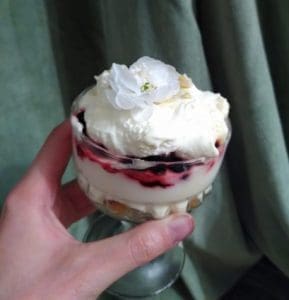
Ornamental varieties with more petals lend themselves to bulk use -try our cherry blossom jam, and once you’ve made it include a layer in cakes, tart, trifle, cheesecakes and any other dessert you can imagine.
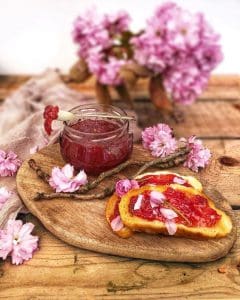
In Japanese cuisine there are hundreds of traditional and modern treats associated with the Hanami blossom festivals in spring – Sakuramochi is particularly famous.
Once the Cherry blossom are preserved with salt and plum vinegar and dried, they can be kept to make sakura tea any time of year
Cocktails beckon with cherry blossom syrup, and blossom infused spirits such as vodka or gin, and you can also use the cherry bark in a dash of wild bitters





